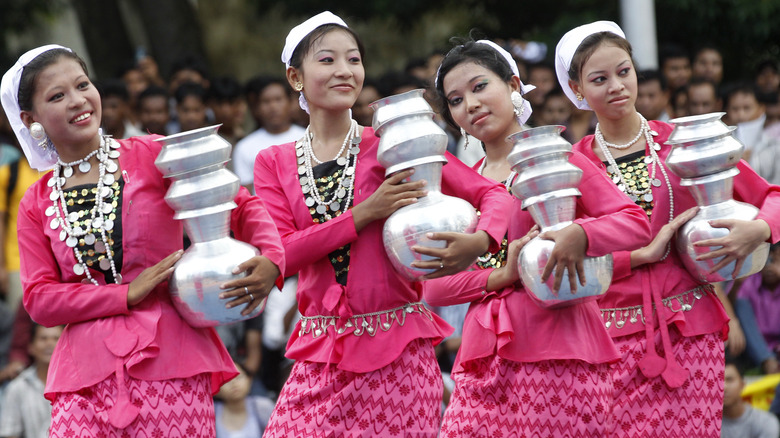How To Know If It's A Costume Or Cultural Appropriation
Indigenous Peoples' Day became a nationally recognized holiday in the United States in 2021, according to the White House. A day rooted in celebrating Indigenous peoples' sovereignty and taking a critical look at Western colonization, cities and states across the country are holding events in honor of Indigenous Peoples' Day.
"Having a federal holiday can serve as less of a celebration but more so a recognition [of] past and present experiences," Scott Stevens, director of the Native American and Indigenous Studies Program at Syracuse University, told USA Today. "I see [Indigenous Peoples Day] as an opportunity to have [a] more critical discussion about our American history, more than what people learn in the fourth grade about the first Thanksgiving and Pocahontas."
In addition to celebrating the contributions of Indigenous groups throughout history, the day offers the chance to reflect on the other big holiday coming up in October: Halloween. We wear costumes on Halloween for a chance to dress up, but it's important to stay mindful when picking a costume for yourself or your child. Conversations about cultural appropriation of Native American and Indigenous cultures have brewed for years. Even those with good intentions can slip into racist costumes around Halloween. These costumes can be the most cringeworthy ones you will see. Don't get caught in an offensive outfit this autumn.
Costumes that can be cultural appropriation
Cultural appropriation occurs "when members of a majority group adopt cultural elements of a minority group in an exploitative, disrespectful, or stereotypical way," according to Britannica. It's not just costumes that can fall into the category of cultural appropriation. A variety of clothes, hair, and even languages can be co-opted by majority groups in offensive ways to a minority group (via USA Today).
But Halloween costumes are one of the major examples of cultural appropriation. NPR reported instances of culturally insensitive costumes on the shelves of retailers that disrespected Arabic, Mexican, and Native American cultures and individuals.
Costumes that are appropriative tend to be based on the cultural outfits of people of color and oppressed groups. Simple signs of cultural appropriation include darkening or lightening skin, using hairstyles that hold significant hairstyles in certain racial groups, or using cultural paraphernalia like Native American headdresses, according to the University of Tennessee Daily Beacon.
How cultural appropriation dehumanizes oppressed groups
Costumes derived from oppressed cultures perpetuate negative stereotypes. For Indigenous people, costumes based on their cultures present "a monolith," Henu Josephine Tarrant told NPR. "It goes deeper than what you're dressed like," the artist and performer from the Ho-Chunk, Hopi, and Rappahannock tribes explained. "When you really look at it and you really study these tropes and stereotypes and what they mean and how they affect us as Native people, you know they're all rooted in a historically violent past."
If your child wants to dress up as Pocahontas, you can use this opportunity as a learning moment. "Parents can gently explain to their children, that depending on the age of the child, maybe a certain costume isn't the best choice because it might make their friends feel bad," Mia Moody-Ramirez mentioned during an interview with USA Today. "It's never too early to learn good manners."
To encourage a child interested in learning more about Indigenous groups, you can still respectfully engage with Indigenous communities online and in-person. According to National Geographic, options include going on nature walking tours in Native lands, enjoying the cuisine at Native-owned restaurants, and immersing yourself in activities open to the public.


